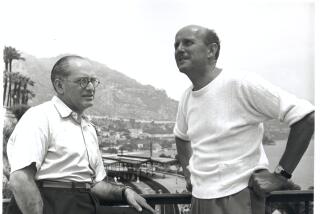A ROYAL REVIVAL OF FILM
Where, I wondered a few years ago, was the next big national film revival going to take place?
I was thinking of the times when a country’s movies suddenly take a quantum leap in quality: when creativity explodes, especially among younger directors. The classic examples: The United States in the 1910s (Griffith, Chaplin), Russia and Germany in the 1920s (Eisenstein, UFA), France in the ‘30s (Renoir), the United States from 1937-1946 (Ford, Welles, Hitchcock), Italy and Japan from 1945-1955 (the neo-realists, Kurosawa, Ozu), France again from 1959-1967 (the “Nouvelle Vague”); Brazil and Eastern Europe (especially Czechoslovakia) in the late ‘60s, West Germany and the United States in the early ‘70’s, Australia five years ago.
So where was the next one? India? South America? (My bets were on my grandparent’s homeland, Scandinavia.) But the answer I usually got--from habituees of international festivals--was a shocker. They insisted that the ‘80s film New Wave was coming out of the British Isles.
Britain? The country which once inspired Francois Truffaut to remark that the words British and cinema were inimical? The country whose greatest film makers either left (like Hitchcock and Chaplin), were mavericks (Michael Powell, Humphrey Jennings), or seemed to dry up or bloat in their later years (Carol Reed, David Lean)? The country where the movies always seemed servile to drama and literature--with actors and writers dominating the directors? Britain?
That’s what they said a few years back. And, in the past year, their predictions have seemed uncanny. We’ve had, or will have, Stephen Frears’ salty “My Beautiful Laundrette,” Terry Gilliam’s savagely comic “Brazil,” Julien Temple’s pop-lyrical “Absolute Beginners,” Gavin Millar’s wistful “Dreamchild,” American James Ivory’s lush “A Room With a View,” Alex Cox’s scathing “Sid and Nancy,” Alan Bridges’ elegiac “The Shooting Party,” a formidable trio from Irish novelist-film-maker Neil Jordan (“Danny Boy” “The Company of Wolves” and “Mona Lisa”)--and dozens of others.
Those are just a few recent films: other current British lights--some brilliant, all interesting--include Peter Greenaway (“The Draughtsman’s Contract”), Scotland’s Bill Forsyth (“Local Hero”), Terry Jones and pals (the Monty Python movies), Roland Joffe (“The Killing Fields”), and Marek Kanievska (“Another Country”).
Add the slightly older, still vigorous, generations--the commercial virtuosos (Ridley Scott, Hugh Hudson, Alan Parker), the TV docu-dramatists (Michael Apted, Ken Loach, Mike Leigh), and the ‘60s group (Nicolas Roeg, Ken Russell, John Boorman, Karel Reisz)--and you’ve got a formidable, if sometimes wandering, assemblage. From many of them, you have now a series of films that reflect on, exalt or expose contemporary British life: in ways alien to mainstream U.S. films.
How did this happen? If it’s a national revival, it’s often an unchauvinistic one--despite scenarist Colin (“Chariots of Fire”) Welland’s notorious Oscar night exhortation: “The British are coming!” Some of the film makers take an irreverent view of the whole situation: Neil Jordan says that until Ken (“Kes” ) Loach--a major inspirational figure--is working regularly in movies again, the so-called renaissance is a sham.
In some ways, the current ferment--like the ones in ‘40s Italy and Japan--comes from social breakdown: Britain’s current multitude of problems--economic, political and cultural--makes it a great subject for a young film maker (as postwar Rome was for Rossellini, Fellini, Antonioni and De Sica). And the contemporary doldrums in British pop music and theater, has diverted a lot of potential talent into the movies.
There are other factors: receptivity and economy. The great British film revival has been accomplished, in part, because there’s an audience for it in Britain (and elsewhere), and because--Goldcrest’s current problems aside--the films don’t cost much to make.
Economy breeds creativity--just as the inflated U.S. studio budgets (a bewildering $15 million on the average) often seem to strangle it. And there have been British producers, like David Puttnam or Stephen Woolley, who have sweated to encourage new talent and “dangerous” projects.
Perhaps more important, there’s been British television--including that all-important catalyst, Channel 4 (guided by Jeremy Isaacs and David Rose), which yearly invests millions of pounds in film projects categorized in advance as unusual, creative or “minority” endeavors.
You might imagine the channel as a form of state subsidy given to creative film makers--like Australia’s or West Germany’s. Not so: The money comes solely from TV commercials, sold on Channel 4 and Britain’s main commercial channel--and diverted, by law, into the Channel 4 film development fund.
Obviously, a similar arrangement could be developed for U.S. TV. And, sadly, it almost certainly won’t--though PBS’ “American Playhouse” offers a teasing suggestion of the possibilities.
What are the qualities of the current renaissance? Feistiness, dash, daring, a love of movie pyrotechnics, a razor eye for the textures of British life (and dreams that fuel it), a broad intellectual reach, mordant or iconoclastic humor, sometimes high social purpose and sheer joie de vivre-- all those characteristics we see in many national film revivals.
But also something which seems particularly British: a sense of irony and a high literacy. It’s rare that a successful British playwright doesn’t eventually write for the screen. Harold Pinter does so, repeatedly, and playwright-scenarists like Pinter, Tom Stoppard, Shelagh Delaney (“Dance With a Stranger”), David Hare (“Wetherby”) and Dennis Potter (“Dreamchild”)--or writer-directors like Jordan, Forsyth and Greenaway--give the current movies a wit, soaring language, cutting precision and, often, a genuine poetry--which stimulates the always prodigally gifted British acting pool as well.
Today, you can see in Britain the dramatic and literary traditions fusing with the cinema, nourishing it--as they should, and don’t, in U.S. movies. How this revival develops is open to question. (Will Puttnam, recently named Columbia Pictures chief, spark something similar here?) But, for the while, it’s enough simply to enjoy it--before the time comes round for Denmark, China, Argentina or Sri Lanka.
More to Read
Only good movies
Get the Indie Focus newsletter, Mark Olsen's weekly guide to the world of cinema.
You may occasionally receive promotional content from the Los Angeles Times.










